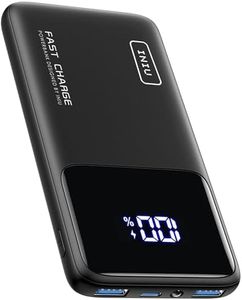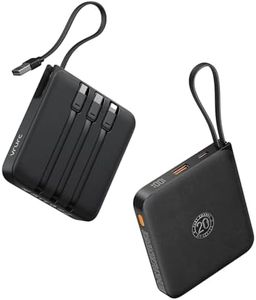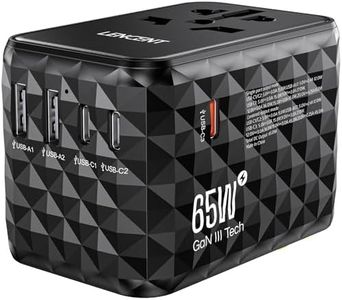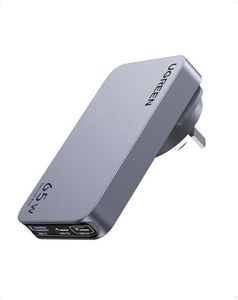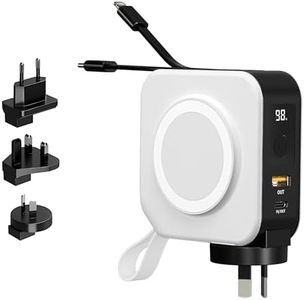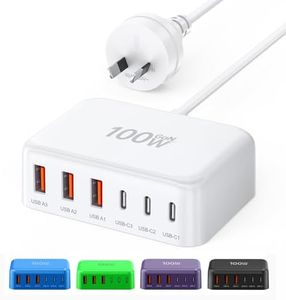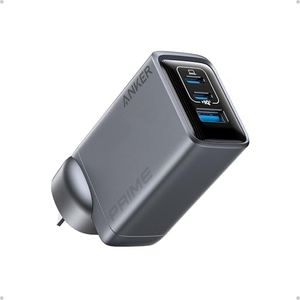We Use CookiesWe use cookies to enhance the security, performance,
functionality and for analytical and promotional activities. By continuing to browse this site you
are agreeing to our privacy policy
10 Best Travel Chargers
From leading brands and best sellers available on the web.Buying Guide for the Best Travel Chargers
Choosing the right travel charger ensures you can keep your devices powered up wherever you go. The best fit for you depends on what devices you travel with, where you’re traveling, and how many gadgets you need to charge at once. Take some time to understand both your charging needs and the technical details behind these chargers so your choice will serve you well on the road and at home.Number of PortsThe number of ports determines how many devices you can charge at the same time. Chargers with a single port are smaller and lighter, great for minimalists or when you mostly charge one device at a time. Multi-port chargers can handle several devices—useful for travelers with a phone, tablet, laptop, smartwatch, or for sharing with others. Decide how many devices you frequently need to charge, then choose a charger with enough ports to cover that, with perhaps one extra for flexibility.
Port Types (USB-A, USB-C, etc.)Port types (such as USB-A or USB-C) refer to the kind of cables and devices compatible with the charger. USB-A is the traditional rectangular port, while USB-C is smaller, reversible, and becoming standard for many devices, including newer phones, tablets, and laptops. If your devices mainly use USB-C, choose a charger with more USB-C ports; if you still use older devices, make sure some USB-A ports are included. Look at what cables and devices you will use most and match the charger to your needs.
Maximum Power Output (Wattage)Power output, measured in watts (W), tells you how fast the charger can provide energy to your devices and whether it can handle larger gadgets like laptops. Lower wattage chargers (like 10–18W) are fine for phones and small electronics but may charge tablets and laptops slowly or not at all. Mid-range chargers (20–45W) work for most phones and tablets, while higher wattage (45W or more) is best if you need to charge laptops or charge multiple devices quickly. Choose based on the devices you need to charge; if you travel with a laptop, look for higher wattage.
International Voltage CompatibilityInternational voltage compatibility means the charger can handle different electrical standards around the world, typically 100V–240V. This is crucial for travelers going to different countries, so your charger works with varying wall voltages. Most travel chargers are designed for this, but always check. If you only travel in your country, this may be less important. Frequent international travelers should ensure the charger is compatible to avoid damage or charging failures.
Plug Adapter InclusionPlug adapters let your charger fit into different types of wall sockets used in other countries. Some travel chargers come with interchangeable plug heads or a built-in universal adapter. If you travel to several regions, check if your charger includes or supports adapters for your destinations. If it doesn’t, you’ll need to buy adapters separately. Think about where you’ll travel most often, and ensure your charger’s plug(s) will fit.
Size and WeightSize and weight are especially important for travel, as bulky chargers take up valuable space in your luggage and can be inconvenient to carry. Smaller, lighter chargers are perfect for light packing and short trips. If you’re carrying more devices or need higher power, larger chargers may be necessary, but today many companies make compact chargers with high output. Balance your need for portability with your need for power.
Safety FeaturesSafety features protect both your devices and the charger itself from issues like overheating, overcharging, or power surges. Common protections include short-circuit protection, temperature control, and automatic shut-off. These are important for peace of mind, especially when charging expensive or sensitive electronics. Always check that the charger includes these safety features, especially if using it in unfamiliar places or with unstable power supplies.

